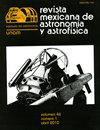HD 5980风-风碰撞的观测约束
IF 1.7
4区 物理与天体物理
Q3 ASTRONOMY & ASTROPHYSICS
Revista Mexicana de Astronomia y Astrofisica
Pub Date : 2022-10-01
DOI:10.22201/ia.01851101p.2022.58.02.19
引用次数: 0
摘要
对Wolf-Rayet系统HD 5980 60年来观测到的谱线轮廓变化的分析得出结论,该系统的可变成员恒星A一直主导着风碰撞区(WCZ),这与1994年之前更强的风属于其近亲恒星B的说法相反。观测到的变化是由物理掩星、风食以及WCZ的发射和吸收共同造成的。在第二次日食期间,当它穿过我们的视线到达A星时,可以清楚地看到围绕B星折叠的WCZ分支所造成的影响。这些效应可以影响WCZ的速度和密度结构。我们推测,在同一轨道相位但在不同时期的线剖面差异可能与WCZ辐射特性的变化有关。2017-2020年的光谱表明,HD 5980的活性状态高于2010-2015年。本文章由计算机程序翻译,如有差异,请以英文原文为准。
OBSERVATIONAL CONSTRAINTS ON THE HD 5980 WIND-WIND COLLISION
Analysis of spectral line profile variations observed over 6 decades in the Wolf-Rayet system HD 5980 lead to the conclusion that Star A, the variable member of the system, has always dominated the wind collision zone (WCZ), contrary to suggestions that before 1994 the stronger wind belonged to its close companion, Star B. The observed variations are caused by a combination of physical occultations, wind eclipses and emission and absorption originating in the WCZ. The effects caused by the leading WCZ branch, which folds around Star B, are clearly seen as it crosses our line of sight to Star A during the secondary eclipse. These effects can inform on the WCZ velocity and density structures. We speculate that differences in line profiles at the same orbital phase but at different epochs may be linked to changes in the WCZ radiative properties. The 2017-2020 spectra indicate that HD 5980 was in a higher activity state than during 2010-2015.
求助全文
通过发布文献求助,成功后即可免费获取论文全文。
去求助
来源期刊

Revista Mexicana de Astronomia y Astrofisica
地学天文-天文与天体物理
CiteScore
1.30
自引率
10.00%
发文量
14
审稿时长
>12 weeks
期刊介绍:
The Revista Mexicana de Astronomía y Astrofísica, founded in 1974, publishes original research papers in all branches of astronomy, astrophysics and closely related fields. Two numbers per year are issued and are distributed free of charge to all institutions engaged in the fields covered by the RMxAA.
 求助内容:
求助内容: 应助结果提醒方式:
应助结果提醒方式:


